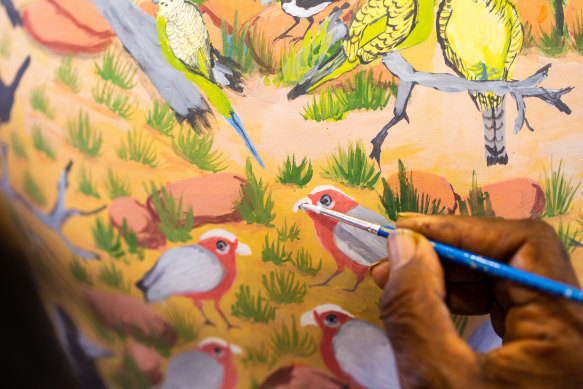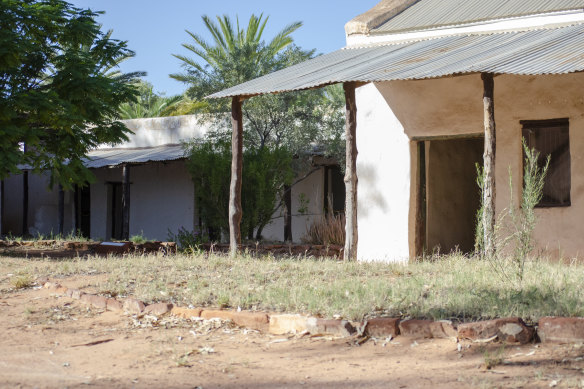Remote red-dirt town hides one of Australia’s most prized art centres
By Andrew Bain
In Hermannsburg, they’re painting the town red, white and blue. It’s grand final week and the Western Aranda Bulldogs are a chance to bring home a premiership against Papunya. Cars drive through the streets sprayed in team colours, and outside the studio of the Hermannsburg Potters, red, white and blue streamers fly from the fence above a bulldog statue wearing a team guernsey. The real trophies here, however, are inside this studio.

A Hermannsburg artist at work.
The Aboriginal community of Hermannsburg, 125 kilometres west of Alice Springs, is synonymous with art. Known to the Arrernte people as Ntaria, it was the birthplace of Albert Namatjira, has lent its name to the Hermannsburg School art movement, and has more recently seen the Hermannsburg Potters emerge as one of central Australia’s most distinctive and recognisable art centres.
The rudimentary studio is entered through its showroom, where about a dozen pots in customary playful design are on display. To the left, in a larger room, a trio of artists is at work and I’m quickly welcomed in by Rona Rubuntja, a deaf potter and artist who has been working with the studio since 1998, just eight years after Hermannsburg Potters was established.
In her Bulldogs team colours, Rona guides me around the studio, where she’s putting the finishing touches on a two-foot-high pot while, around her, other pots are being prepared and packed to be sent to a distant art fair.
Back outside the studio, there’s no mistaking that Hermannsburg is Namatjira country – a six-metre-high monument honours the artist on the approach to town, while Namatjira’s hand-built former home sits three kilometres beyond the community – though art was the furthest thing from the minds of the town’s founders.
Hermannsburg was settled by Lutheran missionaries from Hahndorf, South Australia, in 1877. They walked overland for 20 months to establish the Finke River Mission Station at this site, chosen for its proximity to permanent water at Kuprilya Springs. For a time, it was the largest settlement in central Australia.

One of the restored Hermannsburg buildings.
Today, the original settlement – one of the few surviving outback mission stations – stands preserved as the Hermannsburg Historic Precinct, a collection of whitewashed buildings huddled at the base of the remote James Range. Beyond the precinct, the Finke River carves its way through the range below Mount Hermannsburg, creating a gorge that now forms the approach to Palm Valley.
The town that replaced the mission remains wrapped around the edge of the historic precinct, and continues to draw its water from Kuprilya Springs almost 150 years on. Now a ghost town among ghost gums, the historic precinct has long been Hermannsburg’s prime visitor attraction, enhanced by a $5.5-million upgrade completed in November 2022.
As part of the restoration, original mortar was painstakingly replaced using heritage materials, stonework was repaired and whitewashed, paths upgraded, new signage installed and gardens landscaped.
The most observable repair was to the small meat house, the first building visitors pass as they enter the precinct. A wall that was near collapse has been rebuilt, piecing back together the room that stored the carcasses of the mission’s sheep (there was a flock of 3000 sheep until they proved unsuited to the country) and then cattle.
Inevitably, the mission’s church sits at the heart of the precinct, but the most intriguing buildings form a ring around its dusty yard. The mission’s former bakehouse – now the visitor centre – was constructed from flattened and recycled 44-gallon drums after World War Two. Opposite it, the homestead of the mission superintendents now houses the Kata Anga Tea Rooms. Playing to Germanic history, it’s the most remote place you might ever eat apple strudel.
Hermannsburg’s oldest building, the 1882 Smithy, is cocooned within a more prosaic 1960s metal-frame building, while the defunct Tannery is the precinct’s largest building and once its economic force, producing leather goods of such quality that it became one of the original suppliers to RM Williams.
Even here, among the bones of Hermannsburg’s history, art has its place. Inside the historic precinct’s garage workshops, a small side room contains an art space worthy of a major city gallery. Around its walls and a bronze sculpture of a seated Albert Namatjira are landscape paintings by Hermannsburg artists, including four of Namatjira’s eight children and granddaughters Lenie Namatjira and Betty Namatjira Wheeler.
German missionaries and footy seasons come and go – the Bulldogs lost the grand final – but these are names that will be forever connected to Hermannsburg.
THE DETAILS
See
Hermannsburg Historic Precinct is open from April to October. See hermannsburg.com.au
Hermannsburg Potters is open by appointment from Monday to Friday; book online at hermannsburgpotters.com.au/visit
The writer travelled courtesy of NT Tourism.
Sign up for the Traveller Deals newsletter
Get exclusive travel deals delivered straight to your inbox. Sign up now.